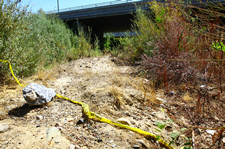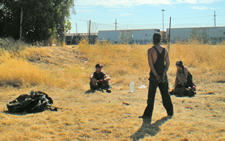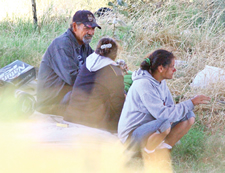Red Grass, Cold Rails
by Scott Thomas Anderson
The Press Tribune.

Crime tape still remains in the
spot John Alpert's body was found in
Roseville. Photo by Philip Wood.
For more than a century, Roseville’s massive switchyards have been a destination for wandering train-hoppers — groups of roving boxcar transients who play into a half-romantic image of the ultimate quest for freedom. But Roseville police detectives say there’s nothing nostalgic about their current homicide investigation along the city’s steel lines: Tragic and disturbing, the case appears to be the second instance in recent years where a slaying has been triggered by the intersection of two very different groups of modern rail-riders.
New Investigation

John Alpert.
Sunlight moves over what’s left of the police tape, a crumpled snake of spattered yellow tangled in wet mud and swaying weeds. Dry Creek glimmers against daybreak. Roseville police detective Vince Dutto looks down at a bed of stones: Here was the final terminus point for 19-year-old John Alpert. Dutto knows his department has solved a case like this before, though all that matters now is this newest victim.
On May 15, 2013, a fisherman was walking along Dry Creek when he stumbled into a hidden train-hoppers’ camp off Atkinson Road. The man saw no signs of homeless squatters, though he did notice something odd in the bushes along the water. Taking a closer look, he realized he was staring at the remnants of a human body. Dutto and other Roseville police detectives were called to the scene. Probing the area, they noticed several suspicious circumstances. They immediately set up a perimeter and called for a Crime Scene Investigation unit.
Dutto remembers looking down at the body for the first time. Sun-beat bones. A supine posture. Naked and in an advanced state of decay.
“It wasn’t much to work with,” Dutto recalls, walking the murder scene again. “We could tell it had probably been there for a couple of months. They had no way to even identify him at first.”
The remains underwent a lengthy examination by the Placer County coroner in concert with the forensic anthropology lab at California State University, Chico. By June 28, Roseville police knew the body belonged to John Alpert, a kid who’d grown up in Palmdale, California. They also knew Alpert had died from major unexplained blunt-force trauma to his body. Alpert had been listed as an official missing person with the Los Angeles County Sheriff’s Department for months.
According to Roseville police, Alpert was a well-liked, active college student with no history of troubled or risky behavior. In the spring, he reportedly left Palmdale to go on a trip with a group of people he had met. Alpert’s family told investigators they believed those individuals were experienced train-hoppers. Dutto’s current investigation supports the same conclusion. A week after leaving, Alpert’s loved ones lost all contact with him. Family members and close friends never heard from him again.
Moving past rusted pots and a dusty mattress under the bridge, Dutto goes step by step through the timeline he’s been working on for months. “We know our victim was in Roseville in March,” he observes. “We know that people saw him here before this happened.”
The sun moves over the detective’s shaven head and the dark shields of his sunglasses. “And we know we have a victim who was much beloved to his family and his community,” he adds. “And they really want to know what happened to him.”
A Tale of Train Cultures

Train-hopper Kory Fanson gets arrested near
March Lane in Roseville. Photo by S.T.A.
Editor’s note: Scott Thomas Anderson was present for Kory Fanson’s arrest.
On a warm summer morning in August, Roseville police officer Dave Flood spots the rail-riders trespassing on Union Pacific property off March Road: two young men, a young woman and pit bull. Flood approaches the group. Kory Wayne Fanson, originally from Tacoma, Wash., is sun-scorched and shirtless in a pair of oil-ruined overalls. His girlfriend, Valerie, who hails from Pennsylvania, sits quietly in dirty, torn clothes as she pets the dog. Valerie is six months pregnant. Michael Bray, from parts unknown, looks on with smudged shorts, a messy t-shirt, a weathered bandana on his neck and Willie Nelson-style pigtails hanging under his ball cap. An empty bottle of booze is anchored next to the group’s backpacks in the weeds. A faded copy of Williams S. Burroughs’s novel, “Junky,” lies next to it. It is Fanson’s book. He knows that in 1951 Burroughs’ accidently killed his wife with a gun trying to shoot a bottle off her head in Mexico City.
“It’s a popular book in the traveling community,” Fanson confirms. “But it’s a popular book with all kinds of different people.”
As Flood runs a radio check on the three subjects, Valerie notices his nameplate. “Hey, I’ve heard of you!” she says cheerfully.
“Yeah, I’ve heard of you, too,” Bray adds in a less happy tone. “I first heard about you when I was up in Colorado. They say you’ve got 250 cameras here in the city that you can see through.”
The officer nods, finishing his radio check. “Yeah, I can watch those cameras in my patrol car,” he assures the group.
“Yeah, Flood is famous throughout the whole United States,” Bray mutters grimly to the others.
Flood tells Fanson there is a warrant for his arrest for allegedly fighting at the Roseville Amtrak station. Fanson is calm and cooperative, giving Valerie instructions on how to find him again when he’s released from the Placer County Jail in Auburn. Smiling, his girlfriend keeps the conversation with Flood positive. As the Roseville Police Department’s expert on train-hopping, Flood is always looking for more insight into how the “traveling community” thinks. Before leaving, he asks Valerie why rail-riders have such an all-out hatred for Roseville’s local homeless population, whom they dismissively refer to as “home bums.”
“I don’t like home bums,” Valerie admits. “I feel like if I was in one place, I’d have a job and I wouldn’t be mooching and begging off people. I just don’t agree with that. Actually, I’m going to have to settle down somewhere soon myself, to have this baby. Kory and I would have already been on our way up north, but, honestly, we’re having a hard time figuring out this train yard.”
On the way to Auburn Jail, Fanson mentions he’s been hitching on box cars across the nation for two years.
“I basically didn’t have anything going on at home,” he says. “I couldn’t find any work, so there was nothing there for me.”
Fanson also tells Flood he’s read quite a bit about him in various online train-hopper forums. The fact that a Roseville police officer assigned to homeless issues and transient enforcement is being mythologized from library computers as far away as Alaska is proof of just how vital Roseville’s Union Pacific switchyard is to the underground world of rail-riders. In the years Flood has dealt with these personalities moving through his beat, he’s noticed they break into several different cultures: One group is largely high school runaways and college-age adventurers looking for a life less ordinary, moving freely from city to city, heading from one music festival to another to the next big “meet-up” event. These are the freewheeling “travelers” that Fanson, Bray and Valerie associate themselves with.

A self-identified member of the Freight Train Riders
of America drinks a beer at train-hoppers camp
just beyond Roseville. Photo by Philip Wood.
But Flood knows better than anyone there’s a far different group on the periphery of the rails — violent criminal drifters intentionally staying out of the reach of mainstream society and law enforcement. In 2011, Roseville police arrested a rail transient named Michael Adams for beating to death another train hopper, John Owens, near the city’s central lines. Adams, better known as “Dirty Mike,” claimed to be an enforcer for the reputed gang known as the Freight Train Riders of America. Adams was also a confirmed suspect in the fatal bludgeoning of a woman near a railyard in El Paso, Texas. According to federal authorities, “Dirty Mike” also told a Washington sheriff’s deputy he was involved in two other murders that have yet to be solved.
Separate from that incident, Flood was contacted last year by an FBI agent investigating the brutal kidnap and rape of a woman in Texas. The agent said his two suspects were train-hoppers, and their Facebook accounts mentioned having a run-in with Flood in Roseville the week before they kidnapped their victim.
“It’s difficult to get good intelligence on train gangs and other criminals who are part of that lifestyle,” Flood notes. “They’re here and then they’re gone. They come through a place like Roseville once, and you might never see them again.”
Growing Tensions
The “Dirty Mike” killings continued to spur a dark image for the Freight Train Riders of America, or F.T.R.A. This was largely because “Dirty Mike” reportedly claimed to be a proud prodigy of the train-hopping serial killer John Boris, a.k.a. “Dog Man Tony.” An even more infamous member of F.T.R.A. is Robert Joseph Silveria Jr., known to rail-riders as “Side Track” and featured on “America’s Most Wanted” as “The Box Car Killer.” Silveria has been convicted of four murders in three states, and is suspected of slaying as many as 23 additional victims in the mid-1990s. He was finally captured by authorities, just 16 miles from Roseville, in Auburn in 1996.

A self-claiming "Enforcer" for the F.T.R.A. sits back and
waits for a train near Roseville. Photo by Philip Wood. .
On September 4, 2013, two reporters from The Press Tribune and Placer Herald went into a train-hoppers’ camp past the southern outskirts of Roseville and talked to a man who claimed to be an enforcer for the Freight Train Riders of America. He asked the Press Tribune to withhold his name because he was not authorized to speak with journalists by the F.T.R.A. Council. The “enforcer” denied that F.T.R.A. is a criminal gang, characterizing the group as rebellious nomads. He also asserts that the group was started by angry Vietnam veterans in the early 1980s, and the original name behind F.T.R.A. was Fuck The Reagan Administration.
“There are very few of us left out here who are true F.T.R.A.,” the enforcer said. “And because of guys like ‘Side Track’ and ‘Dirty Mike,’ we’re pretty misunderstood. I knew ‘Dirty Mike’ well. He started as F.T.R.A., but he went renegade, and now he’s in prison, which is exactly where he belongs.”
The “enforcer” and three other purported F.T.R.A. members told The Press Tribune their group is not what poses the real threat to college-aged thrill-seekers looking to find themselves on the rails — rather, most violence now comes from a new generation of erratic, unstable young drifters, some of whom identify themselves as “The Wrong Way Kids,” and others who call themselves “Agro Kids” or “Crusty Punks.” A review of known train-hopper forums online can find countless mentions of these groups.
“Sometimes I get tears in my eyes when I think of all the things that have been going on out here lately,” the enforcer said. “I’m telling you, it’s not how it used to be … We may be ‘trampin,’’ but we (F.T.R.A.) have rules. Some of these kids now have no rules, no code, no values to anything. They do whatever they want, when they want.”
He added, “And these kids are trying to push us off the lines; but I’ve got news for them: F.T.R.A. isn’t going anywhere.”
As the detective charged with John Alpert’s murder investigation, Dutto has been learning about the tensions between the F.T.R.A. and groups such as the “Agro Kids” and “Crusty Punks.” Walking Alpert’s crime scene with Flood, Dutto noticed some graffiti about 100 feet away from where the body was found: The spray-painted message had originally said F.T.R.A., though someone else finished the letters off with a new insult, Fraid To Ride Alone.
“That’s this younger group of riders taunting the older ones,” the detective noted.
Dutto has also found within his research around the case a growing rift between the young, easy-going “travelers” and “squatters,” and the types of violent and volatile personalities “the enforcer” told the Press Tribune about on September 4.
Both Flood and Dutto think there’s a level of danger involved with young adults looking for freedom and self-exploration moving through the same camps as hardened individuals operating on predatory instinct.
“I think when some of the more harmless riders come in contact with the criminal ones, things can definitely go very wrong for them,” Flood concluded.
And that scenario remains at the center of Dutto’s investigation.
“What I can say about John Alpert is that he wanted to go on an adventure, but he had no train-riding experience whatsoever,” the detective said. “It’s a sad case, because by all accounts he was a good kid and a good citizen who appears to have gotten mixed up with the wrong crowd.”
Following the Fleeting
It’s a cold November morning near the city’s switchyard.
Dutto steps out of a downtown coffeehouse with a full view of oil tanks cluttered on the crowded tracks. Alpert’s case is still on his mind. He’s determined to get the kind of result with John Alpert’s case that his predecessors got when “Dirty Mike” murdered John Owen. And there’s a human voice behind Dutto’s drive: He talks to Alpert’s heartsick mother often. He tries to keep her apprised on his progress. He tries to explain to her the steps he and his colleagues are taking to prevent the case from going cold. In a month Dutto will get a nicely worded card from Alpert’s mother in the mail. He’ll hear about the candlelight vigil she’s planning on the death anniversary. Every conversation reminds the detective of the pain his victim’s family continues to endure — the long, throbbing lack of closure that clouds their daily lives.
And so Dutto keeps looking for the closure. He’s walked the Alpert crime scene countless times. He’s combed both sides of the creek as far as anyone is capable of hiking. He’s checked the water levels to see if the banks were ever underwater between when Alpert’s remains were abandoned in March and discovered in May. He’s studied another train-hopper killing that happened in Yuba County, Ca. He’s worked closely Flood, who’s brought him into the train-hopper camps to question everyone the two can find: It is Flood alone who understands the loose network that links city’s homeless community to the boxcar transients coming through Placer County.
While Flood has worked his sources, Dutto’s traveled to Alpert’s hometown of Palmdale to interview more than twenty people who were close to him, creating a detailed victimology.
Winter may be getting closer but Dutto’s case is not. He has started to locate witnesses. He has valuable leads. He’s identified real suspects. There is now a $1,000 reward for information leading to an arrest. Residents of South Placer may be worried the case is getting away from police, but what they don’t know is that this detective simply refuses to give up.
Walking alongside a reporter in the harsh, early chill, Dutto glances down Bulen Street to the chain-link fence along the rail-yard, where a tin engine silo is reflecting gray and faded under a dull, cloudless sky.
“There’s no way we’re giving up on this case,” the detective says. “We’re going to continue to follow up on every single aspect of it. We’re not going to stop.”
